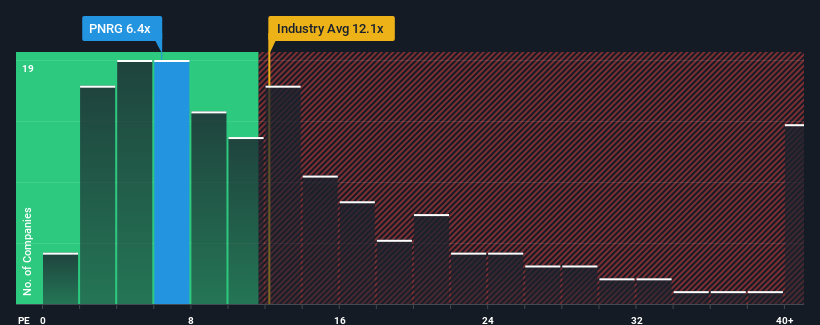- United States
- /
- Oil and Gas
- /
- NasdaqCM:PNRG
PrimeEnergy Resources Corporation's (NASDAQ:PNRG) Share Price Boosted 25% But Its Business Prospects Need A Lift Too
PrimeEnergy Resources Corporation (NASDAQ:PNRG) shareholders have had their patience rewarded with a 25% share price jump in the last month. The last month tops off a massive increase of 123% in the last year.
Even after such a large jump in price, PrimeEnergy Resources may still be sending very bullish signals at the moment with its price-to-earnings (or "P/E") ratio of 6.4x, since almost half of all companies in the United States have P/E ratios greater than 20x and even P/E's higher than 35x are not unusual. Although, it's not wise to just take the P/E at face value as there may be an explanation why it's so limited.
Recent times have been quite advantageous for PrimeEnergy Resources as its earnings have been rising very briskly. It might be that many expect the strong earnings performance to degrade substantially, which has repressed the P/E. If you like the company, you'd be hoping this isn't the case so that you could potentially pick up some stock while it's out of favour.
View our latest analysis for PrimeEnergy Resources

How Is PrimeEnergy Resources' Growth Trending?
PrimeEnergy Resources' P/E ratio would be typical for a company that's expected to deliver very poor growth or even falling earnings, and importantly, perform much worse than the market.
Retrospectively, the last year delivered an exceptional 74% gain to the company's bottom line. Although, its longer-term performance hasn't been as strong with three-year EPS growth being relatively non-existent overall. Therefore, it's fair to say that earnings growth has been inconsistent recently for the company.
Weighing that recent medium-term earnings trajectory against the broader market's one-year forecast for expansion of 15% shows it's noticeably less attractive on an annualised basis.
With this information, we can see why PrimeEnergy Resources is trading at a P/E lower than the market. Apparently many shareholders weren't comfortable holding on to something they believe will continue to trail the bourse.
The Final Word
Shares in PrimeEnergy Resources are going to need a lot more upward momentum to get the company's P/E out of its slump. It's argued the price-to-earnings ratio is an inferior measure of value within certain industries, but it can be a powerful business sentiment indicator.
We've established that PrimeEnergy Resources maintains its low P/E on the weakness of its recent three-year growth being lower than the wider market forecast, as expected. Right now shareholders are accepting the low P/E as they concede future earnings probably won't provide any pleasant surprises. If recent medium-term earnings trends continue, it's hard to see the share price rising strongly in the near future under these circumstances.
There are also other vital risk factors to consider and we've discovered 2 warning signs for PrimeEnergy Resources (1 shouldn't be ignored!) that you should be aware of before investing here.
If P/E ratios interest you, you may wish to see this free collection of other companies with strong earnings growth and low P/E ratios.
New: Manage All Your Stock Portfolios in One Place
We've created the ultimate portfolio companion for stock investors, and it's free.
• Connect an unlimited number of Portfolios and see your total in one currency
• Be alerted to new Warning Signs or Risks via email or mobile
• Track the Fair Value of your stocks
Have feedback on this article? Concerned about the content? Get in touch with us directly. Alternatively, email editorial-team (at) simplywallst.com.
This article by Simply Wall St is general in nature. We provide commentary based on historical data and analyst forecasts only using an unbiased methodology and our articles are not intended to be financial advice. It does not constitute a recommendation to buy or sell any stock, and does not take account of your objectives, or your financial situation. We aim to bring you long-term focused analysis driven by fundamental data. Note that our analysis may not factor in the latest price-sensitive company announcements or qualitative material. Simply Wall St has no position in any stocks mentioned.
About NasdaqCM:PNRG
PrimeEnergy Resources
Through its subsidiaries, engages in acquisition, development, and production of oil and natural gas properties in the United States.
Adequate balance sheet and slightly overvalued.
Similar Companies
Market Insights
Community Narratives





